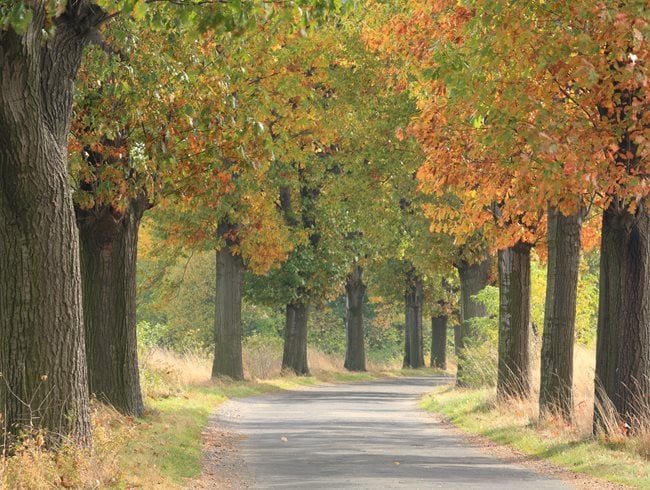Planting Oaks
Doug Tallamy, a professor of entomology at the University of Delaware, shares how you can plant an oak tree in your own backyard.Oaks have a reputation for being hard to transplant successfully. This can be true if you’re seeking instant gratification and attempt to plant an oak that is too big, or a potted oak that is too old. Oaks develop massive root systems which they grow quickly when young—it’s one of the reasons oaks are so good at protecting our watersheds and topsoil. To transplant an oak that’s already several feet tall you have to root prune it nearly to death. If it survives the transplant, it will grow very little for years afterwards as it tries to develop new roots. It is hard to believe but oaks planted as acorns or young saplings catch up and pass 15-foot transplants in just a few years. Finally, large transplanted oaks are expensive, often thousands of dollars for a tree with a 50 percent chance of dying in the first year.

Several Quercus rubra (red oak) line a driveway. At maturity, red oaks reach 50 to 75 feet tall with an equal spread.
Photo by: shapencolour / Alamy Stock Photo.
Potted oaks have similar problems. Oak roots grow so fast that a potted oak can become root-bound in a single season. A potted oak that is 5 feet tall may be root-bound, with a high probability of choking itself to death once in the ground. Trees that have been root pruned when successively moved to larger containers have a good chance of survival, but will not be as vigorous as a tree planted directly from an acorn.
Oaks also have a reputation for being slow-growing. I have heard landscape professionals tell clients not to plant oaks because they won’t live long enough to enjoy them. But that is hardly the case. I am writing this as I sit under a willow oak that I planted 16 years ago from an acorn. It is now over 30 feet tall, and I can assure you, I am enjoying it!
The good news is that all of these problems—transplant difficulties, root-bound plants, and expense—can be easily avoided if you plant your oaks when they are small. Here’s how:
Choose the location wisely. Although some species remain small even when mature (e.g. dwarf chestnut oak), most oaks will become large trees much faster than you think, so picture the area a mature oak (and its root system) will occupy in 20 years.
Start small. Planting an acorn or small seedling is the best way to go. Collect acorns as soon as they fall from the tree.
Acorns from species in the white oak group germinate right away in the fall, so they need to be planted immediately. They will send a radicle (embryonic root) straight down into the soil and spend the winter that way. Then, in the spring, the young plant will shoot up towards the sun. Acorns from the red oak group wait until spring to germinate, so they can be stored through the winter with a little bit of soil in a sealed plastic bag in the refrigerator.
In both cases, I recommend starting your acorns in deep pots and protect them from mice, chipmunks, and squirrels until the plant is well above the soil line. Tend them in their pots through the first summer and then plant them into your yard in early September. Be sure to water them until they are well established.
If you purchase an oak, buy the smallest one the nursery offers. But remember, acorns are free!
Protect your oak from deer. I use five-foot-high wire fencing material and form a cage about 5 feet in diameter around the oak. This might seem like overkill at first, but your oak will fill the cage in just a few years. When the tree grows well about the cage, remove the cage and loosely wrap the trunk with plastic or wire fencing material to discourage damage from “buck-rub” (bucks like to rub their antlers against trees with a 2- to 3-inch diameter trunk). This scrapes the bark off and can easily kill the tree. Be sure to remove the fencing before the tree grows into and around it, and remember that young bark can get sunburned too.
Don’t fertilize your oaks. Oaks are adapted to soils low in nitrogen and doses of fertilizer can trigger rapid growth periods that split the bark or stimulate lush leaf growth that is prone to insect infestation.
Use the right soil. If you are worried that your soil is poor, inoculate the planting site with a little soil and litter from under an established oak of the same species. This introduces the mycorrhizae species that aid nutrient exchange in your oak.
Create the right-size planting hole. You can make the hole wide, but don’t make it deep. The most common source of transplant mortality is from planting a tree below the root-line. Many people dig a deep hole and back fill to the appropriate depth. But the loose soil in the bottom of the hole usually settles a few inches, just enough to sink your tree into the danger zone. Dig your hole no deeper than the root ball of your tree. If you like to dig, make your hole wide, but do not make it deep.
Mulch the right way. You can mulch with oak leaves but do not build a volcano of mulch next to the trunk. This may cause trunk rot.
Editor’s note: For more information on planting oaks, see the University of California page on How to Grow California Oaks. (Although the title refers to “California,” the information is universally appropriate.)
This bonus content accompanies “An Evolutionary Pair”—an article about how the relationship between blue jays and oak trees has shaped the natural world and how you can help that relationship continue—in the Autumn 2017 issue of Garden Design magazine.
